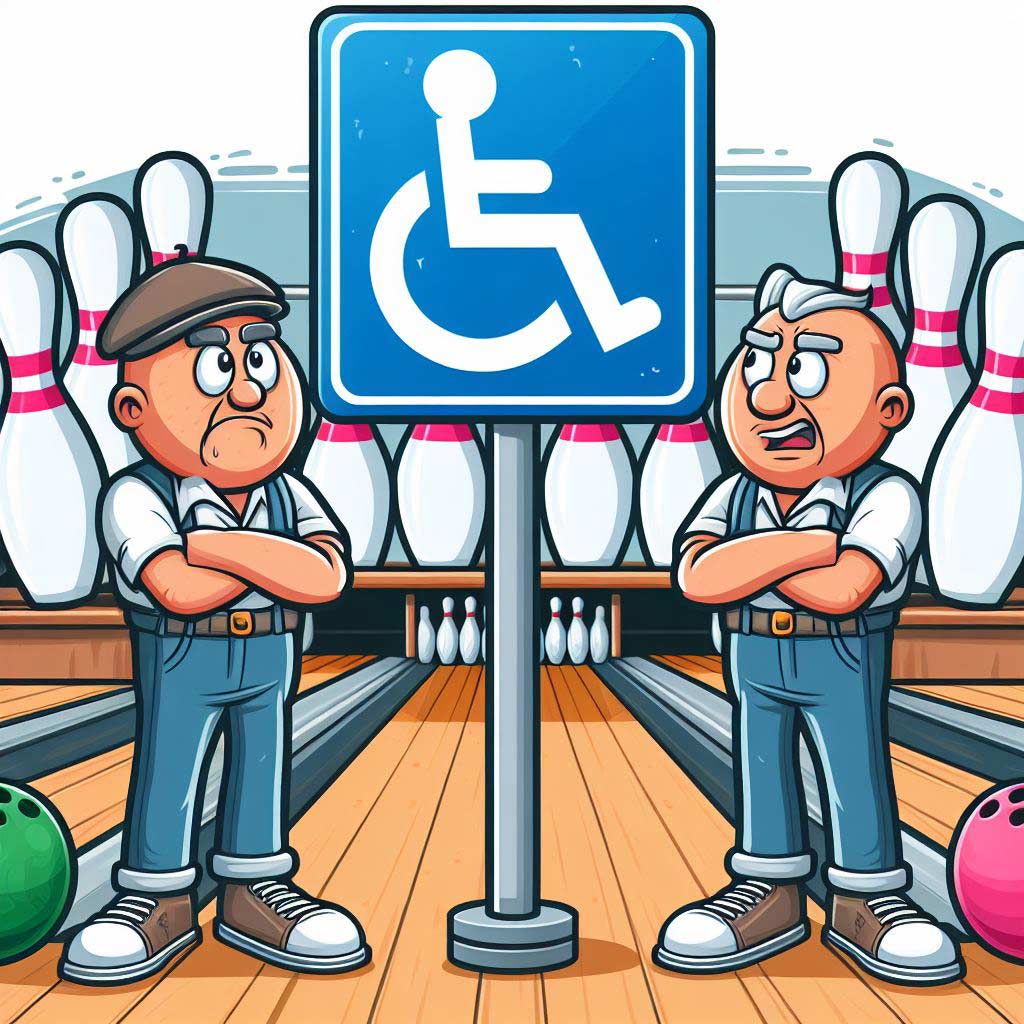Bowling is a beloved sport across all ages and skill levels. From friendly competition between family members to serious league tournaments, it brings people together for tearing down pins and hopefully some strikes and spares!
However, when bowlers with vastly different averages play against one another, things can get lopsided very quickly without handicap scoring in place. This leaves the lower-average bowlers at a frustrating disadvantage each frame.
That’s where handicaps save the day! Handicap calculations enable players of any bowling caliber to contribute meaningfully to a game’s outcome.
By factoring in each bowler’s average, handicaps award score bonuses to even the playing field. This encourages friendly competition and makes every bowling match an exciting battle to the very last frame, regardless of whether you average 70 or 200.
This complete guide to bowling handicap rules will cover everything you need to know. You’ll learn handicap definitions, formulas, sports league regulations, scoring best practices, and tips for bowlers of all skill levels. Time to level those lanes and may the best bowler win!
What is a Bowling Handicap
Put simply, a bowling handicap is a score adjustment technique that allows players with different averages to compete on relatively equal scoring terms.
It helps make contests fair and participation more enjoyable for everyone from novice players to seasoned pros.
Handicaps are based on the mathematical comparison between a player’s average score and the scratch score of 200 in a single game.
This effectively measures their skill level and enables the awarding of bonus pins to help them stay competitive with higher-average opponents.
For example, a bowler who averages 160 would receive a 40-pin handicap per game against a bowler who averages 200 and bowls scratch.
This allows both players to be within striking distance of one another and adds fun suspense and excitement to the match!
Ultimately, incorporating handicaps helps encourage new bowlers to participate while also keeping contests with experienced players competitive and engaging from start to finish.
How Bowling Handicaps Work
Using handicaps in bowling is meant to even the playing field between opponents with mismatched averages.
This allows for confidence-boosting wins for lower-average players and prevents lopsided contests where higher-average bowlers dominate the scorecard every frame.
Handicaps are expressed as a percentage calculated from the standard 200-scratch game. This percentage converts into bonus pins that are awarded to lower-average players per game to help compensate for their average scoring gap.
Here is a breakdown of common bowling handicaps:
- 50 handicap = 25% of 200 scratch game = 50 bonus pins per game
- 80 handicap = 40% of 200 scratch game = 80 bonus pins per game
- 100 handicap = 50% of 200 scratch game = 100 bonus pins per game
And it scales up from there as averages descend. It’s not uncommon for new bowlers to have handicaps exceeding 100 pins when starting. This keeps things exciting as they work on improving their averages!
As an example scenario, let’s look at how a 220 average bowler and 160 average bowler would fare without and then with handicaps:
Scott averages 220 scratch – Julie averages 160 scratch
Without Handicaps
- Scott scores 200, Julie scores 120. Scott wins by 80 pins.
With Handicaps
- Scott bowls 200 scratch
- Julie receives a 120-pin handicap (60% of 200 standard)
- Julie’s score is now 120 (her scratch score) + 120 (her handicap) = 240
- With handicaps, Julie wins by 40 pins
You can see how factoring in the handicap allowed Julie to leapfrog ahead of Scott in the scoring. This makes their contest much more competitive and exciting!
Handicap Formula
The math behind figuring out bowling handicaps goes as follows:
- Subtract the player’s average from the benchmark 200 scratch score
- Divide that number by 2
- The result equals the player’s handicap per game
Using our example above with Julie’s 160 average:
- 200 (benchmark) – 160 (Julie’s average) = 40
- 40 / 2 = 20
- Julie’s handicap is 20 pins per game
Of course, modern scoring systems do all the math automatically. But it’s good to understand the fundamental handicap formula in bowling and why bonuses are awarded the way they are.
Sports League Bowling Handicap Rules
Recreational or sports bowling leagues are where you’ll commonly see handicap calculations used. This allows teams to fill out their rosters with players across different average skill bands and keeps things competitive.
Most sports leagues use team handicaps over individual ones. Under this system, each team has a cumulative handicap calculated from the combined averages of all players on the roster.
Standard league handicap rules include:
- Women receive an 8-pin per-game handicap advantage
- Maximum team handicap caps (often 40 pins per player)
- Handicaps are calculated and adjusted every 15-20 games
- The requirement to bowl at least 12 games to establish an average
Handicapping also introduces potential sandbagging concerns – when players intentionally bowl under their true skill level to garner an inflated handicap advantage. Strict rules around average adjustments and scoring accountability help prevent this.
Handicap Bowling Best Practices
To keep handicap bowling fair and enjoyable, leagues and less competitive tournaments adhere to some best practices:
- Bowlers must establish accurate averages over 12+ games before receiving handicaps
- Handicaps should adjust upward or downward as averages rise or fall
- Individual caps prevent players from receiving extremely high handicaps
- Team handicaps spread advantage across the roster
In more casual pickup games, bowlers may play without a rigid handicapping structure and simply eyeball reasonable bonus pin amounts to award based on observable skill gaps.
This looser format works fine when there is good sportsmanship and no money on the line!
Handicap Scorekeeping and Reporting
Accuracy in scorekeeping and reporting is essential when handicaps are utilized in league play.
Scores must be meticulously documented on team score sheets according to player averages, handicaps, scratch scores, and total scores with handicaps factored in.
Score sheets note each bowler’s:
- Entered average
- Calculated handicap for that session
- Their scratch score bowled
- Handicap pins applied
- Total score with handicap
Additionally, sports leagues mandate submitting completed score sheets to the league secretary or automated scoring system immediately after matches.
This allows timely validation, processing, and auditing of scores to update player averages and league standings.
Consistent handicap score reporting enables fair play and well-organized league management. It also provides the necessary data trails for addressing potential disputes.
Summary & Final Thoughts
Walking through bowling handicap calculations, rules, and best practices provides helpful insight into how scoring adjustments level the playing field.
Handicapping enables exciting, competitive games for bowlers who may otherwise have vastly different skills and average scores.
Ultimately, don’t get intimidated by handicap bowling leagues and tournaments even as a beginner bowler.
Handicaps exist exactly for bowlers like you! With the right bonuses in place, you’ll be amazed at how quickly fun rivalries develop across skill levels.
For experienced bowlers, embrace opportunities to coach and mentor lower-average players in your league or circles.
Helping newcomers enjoy the game more via handicaps keeps bowling lively for everyone. And you may just discover some healthy competition along the way!
Now that you understand the ins and outs of bowling with handicaps, time to polish those balls and shoes for your next alley matchup!
Savor those strikes and have fun watching the pins get mowed down no matter your average or your opponents. Game on!
Frequently Asked Questions
How do you figure out the handicap for bowling?
The bowling handicap is calculated by taking 200 (the scratch score) minus the bowler’s average and dividing that number by 2. For example, 200 – 150 average = 50. Then 50 / 2 = 25-pin handicap.
How does the handicap system work in bowls?
In lawn bowls, handicaps are based on a player’s demonstrated ability. Better bowlers receive smaller handicap allowances. The handicap allows players of different abilities to compete on relatively even terms. Handicaps are adjusted periodically based on performance.
What is a scratch in bowling?
In bowling, scratch refers to a bowler’s actual average or the number of pins knocked down without any handicap or bonus pins applied. It is the baseline score with no handicapping considerations factored in.
Can you have a negative handicap in bowling?
No, bowling handicaps cannot go negative. The lowest possible handicap is zero, which applies to exceptional bowlers who average 200 or above. Handicaps only provide bonus pins, they do not deduct pins for high-average bowlers.
How many scores do you need to calculate handicap?
Approximately 12 games worth of scores are needed for a bowler to establish an accurate average baseline to calculate their handicap. With a reasonable sample size through 12+ games, the resulting average will better reflect their true ability.
What are scratch and handicap in bowling?
Scratch refers to a bowler’s unadjusted average or scores (no bonuses applied). Handicap refers to the number of bonus pins (per game percentage of 200 scratch) that lower average bowlers receive to stay competitive in handicap leagues and tournaments.
Is there a handicap system in bowls?
Yes, lawn bowling and carpet bowling competitions utilize a handicap system so players of different abilities can participate on relatively even terms. Handicap allowances in bowls are periodically adjusted based on performance data.
What does no tap mean in bowling?
In bowling, a “no tap” refers to when nine-pin hits also count as strikes during play. This makes strikes considerably easier and games more competitive between bowlers of mismatched skill levels.
What does BK mean in bowling?
BK stands for “blind score.” It represents leaving a blank frame where no score was bowled due to technical errors, mechanical failures, medical issues, etc. BK frames don’t count against the bowler’s game score.





